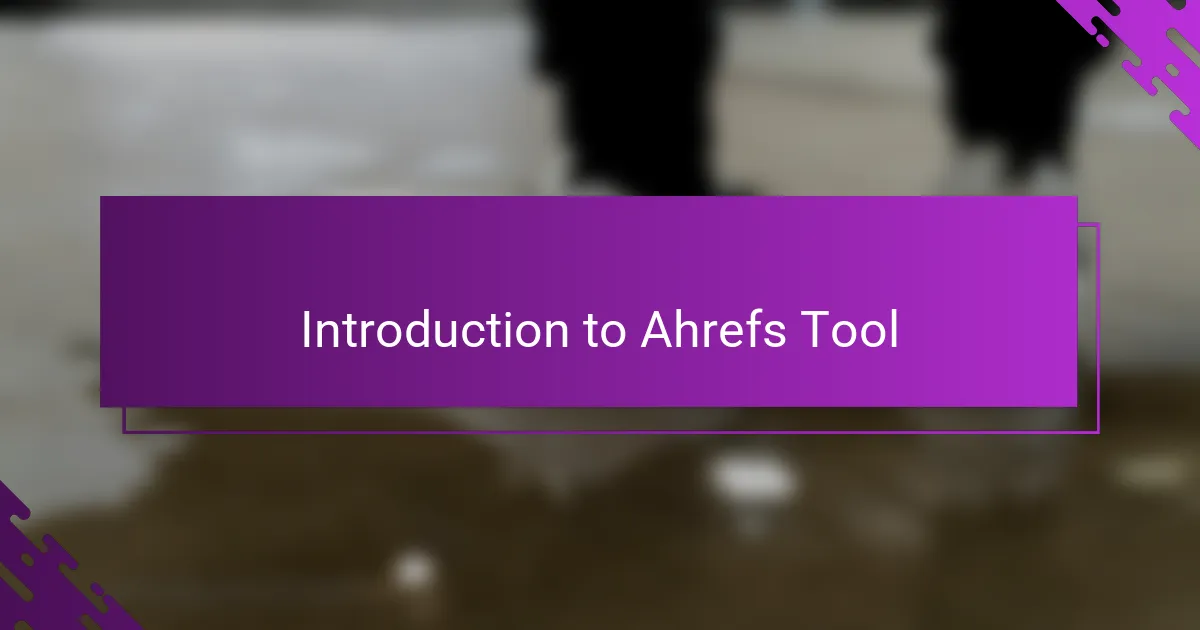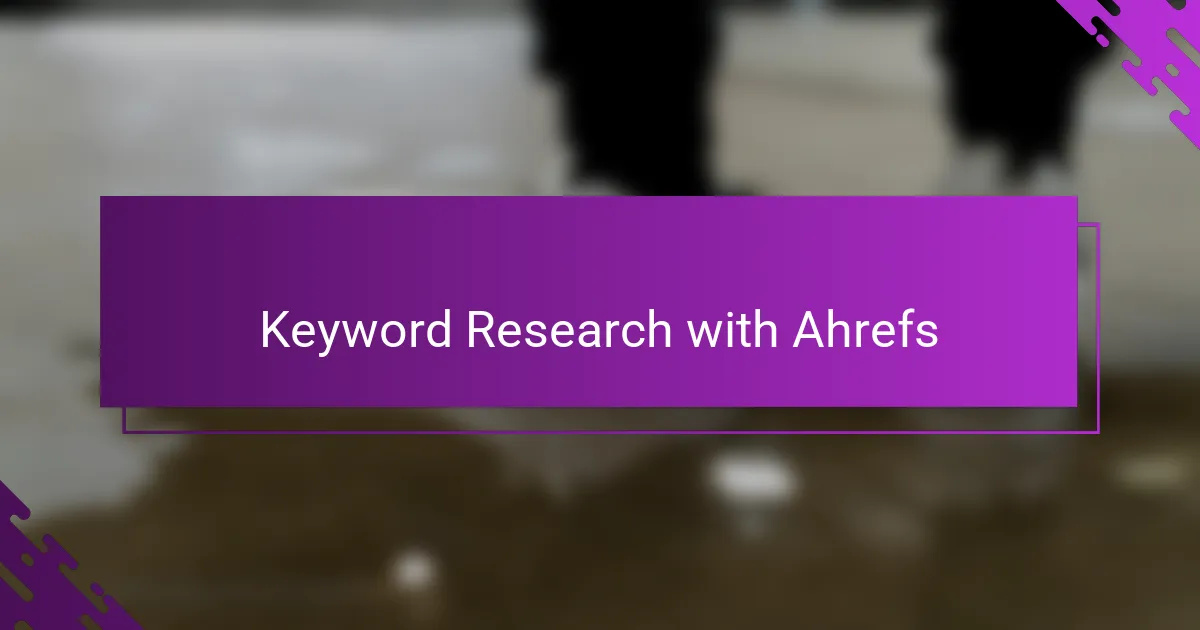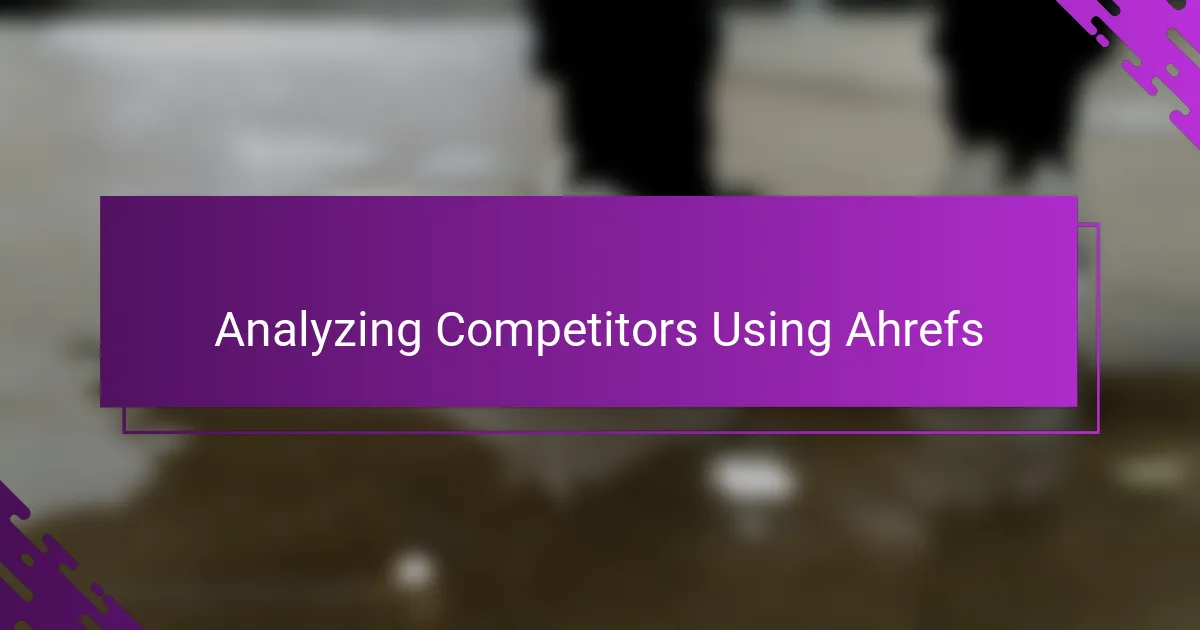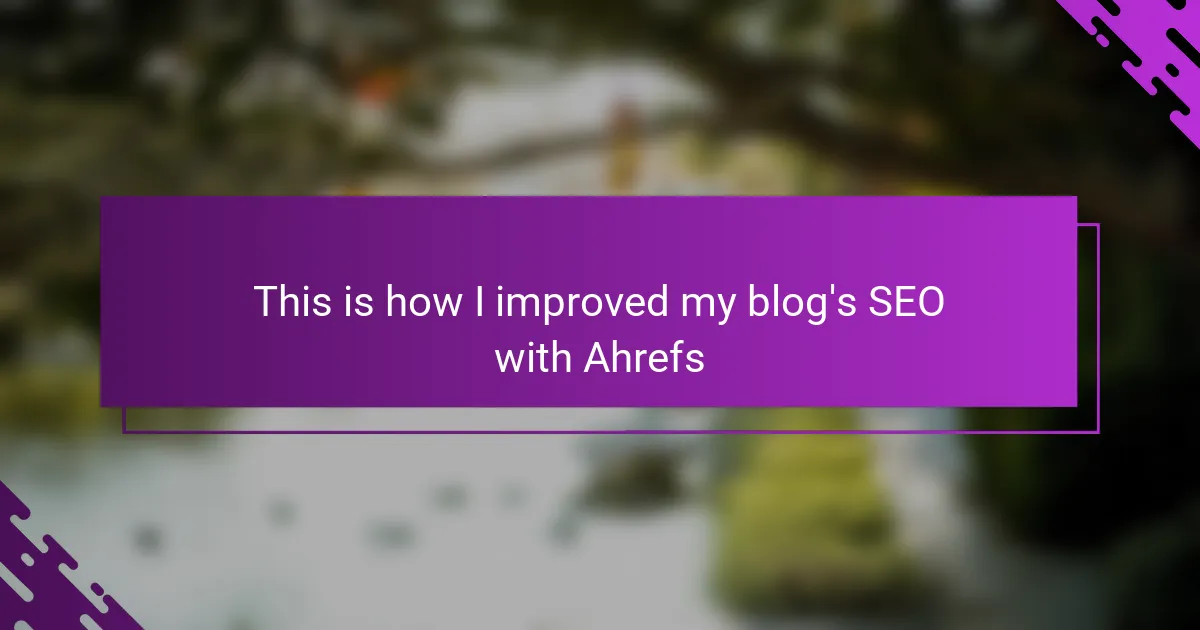Key takeaways
- SEO for personal blogs prioritizes authenticity and understanding reader intent rather than just rankings.
- Ahrefs simplifies SEO with actionable insights, allowing bloggers to track performance and discover keyword opportunities.
- Competitor analysis with Ahrefs reveals untapped keywords and strategies, fostering a growth mindset rather than competition anxiety.
- Regularly tracking SEO progress through Ahrefs provides tangible results and motivation, emphasizing the importance of incremental improvements.

Understanding SEO for Personal Blogs
SEO for personal blogs isn’t just about chasing rankings; it’s about making your voice heard in a crowded digital space. I remember feeling overwhelmed by all the technical jargon until I realized that SEO is really about understanding what your readers are searching for and meeting them there. Have you ever wondered why some posts suddenly get tons of traffic while others barely get noticed?
For personal blogs, SEO means blending authenticity with strategy. It’s about sharing your story in a way that resonates but also signals to search engines what your content is about. I found that when I started thinking of keywords as questions my readers might ask, it shifted my whole approach—less robotic, more human.
Understanding SEO also means appreciating patience and consistency. Growth doesn’t happen overnight, and that’s okay. Reflecting on my journey, the small improvements I made regularly using tools like Ahrefs gave me a sense of control and hope, turning SEO from a daunting task into a creative challenge.

Introduction to Ahrefs Tool
Ahrefs is a powerful SEO tool that quickly became my go-to for understanding how my blog was performing online. At first, I hesitated because it seemed complex, but once I dove in, it felt like having a clear map in a chaotic city. Have you ever wished you could peek into what your readers actually search for? That’s exactly what Ahrefs helped me do.
One of the things I appreciate most about Ahrefs is how it breaks down data into actionable insights. Instead of feeling lost in numbers and charts, I started seeing real opportunities—like which keywords could bring more visitors or which backlinks boosted my blog’s authority. It changed how I approached my content, making SEO feel less like a mystery and more like an exciting puzzle to solve.
Using Ahrefs wasn’t just a technical upgrade; it gave me confidence. Watching my site’s growth through its reports made all the effort worth it, and it reminded me that SEO is a journey, not a one-time fix. Have you ever experienced that moment when a tool shifts your perspective, turning frustration into motivation? For me, Ahrefs was exactly that.

Setting Up Ahrefs for Your Blog
Setting up Ahrefs for my blog was surprisingly straightforward, though I admit I was a little intimidated at first. I started by connecting my website to Ahrefs Webmaster Tools, and that simple step unlocked a treasure trove of data about how my blog was seen online. Have you noticed how just linking your site feels like opening a door to a whole new world of possibilities?
Next, I took the time to explore the dashboard, customizing it to show metrics that mattered most to me—like keyword rankings and backlink profiles. I found that spending a few minutes each day getting familiar with these insights helped me feel more in control, turning raw data into meaningful information. Isn’t it amazing how something that once felt technical and distant can become part of your daily routine?
One thing that really clicked for me was setting up alerts in Ahrefs to track new backlinks or drops in traffic. It was like having a silent assistant watching over my blog, ready to notify me if something important happened. I remember feeling this burst of motivation every time I got one of those alerts—it made SEO feel dynamic and interactive rather than static and boring.

Keyword Research with Ahrefs
When I first dove into keyword research with Ahrefs, it felt like uncovering hidden treasure. Typing in broad topics was just the start—Ahrefs showed me related keywords and how competitive each one was, which helped me choose terms that fit my blog’s unique voice without getting lost in the crowd. Have you ever been stuck wondering what words your readers actually type? For me, this was a game changer.
One feature I grew to rely on was the Keyword Explorer. It didn’t just spit out numbers; it gave me context—search volume, keyword difficulty, even the questions people ask related to my topic. This made me feel connected to my audience’s real needs instead of guessing what might work. It’s like having a direct line to what your readers want before they even click.
I remember spending hours playing around with different keywords, sometimes surprised by which ones Ahrefs suggested. It taught me that popular doesn’t always mean best. Sometimes, targeting less obvious keywords brought more engaged visitors who genuinely cared about my content. Have you experienced that moment when a simple insight shifts your whole approach? That’s exactly what happened when I embraced Ahrefs for my keyword research.

Analyzing Competitors Using Ahrefs
When I first started analyzing competitors using Ahrefs, I was amazed at how much it revealed about their strategies. Seeing which keywords they ranked for and how they built backlinks gave me a clear picture of what worked in my niche. Have you ever wondered why certain blogs seem to effortlessly attract traffic while others struggle? Ahrefs helped me uncover those hidden tactics.
One feature I found invaluable was the Competitor Gap tool. It showed me the keywords my competitors ranked for but I hadn’t targeted yet. This was a real eye-opener—it felt like discovering a roadmap to untapped opportunities. From my experience, knowing where others succeed made me less anxious and more strategic about my own content.
Diving into competitor analysis also sparked a sense of motivation for me. Instead of feeling overwhelmed by competition, I began to see it as a chance to learn and grow. Watching my blog gradually close the gap with others using Ahrefs data was not just rewarding; it made SEO feel like a friendly challenge rather than a race with winners and losers.

Optimizing Content Based on Ahrefs Data
One of the turning points for me was using Ahrefs data to optimize existing content instead of constantly chasing new topics. I’d look at which blog posts were already getting some traction and then dig into Ahrefs to see what keywords they could rank better for. Have you ever felt like some posts just need that extra push? That’s exactly what happened when I added relevant keywords that Ahrefs showed were missing but in demand.
I also started paying close attention to the ‘Content Gap’ reports within Ahrefs. By identifying questions my audience was asking but my blog hadn’t answered, I found new ways to expand and enrich my posts without straying from my original voice. It felt rewarding to know I was not just guessing but truly responding to what readers wanted. Do you think your content could be more targeted? This approach helped me spot blind spots I didn’t even know I had.
Another big insight from Ahrefs was understanding how to structure content better based on what ranks well. I noticed competitors’ posts with clear subheadings and concise paragraphs performed better, so I adapted my style accordingly. It made me realize SEO isn’t about stuffing keywords but about improving readability and clarity—something every personal blogger can relate to. Have you ever tested small tweaks and seen surprisingly big results? That kind of progress kept me motivated to keep refining.
![]()
Tracking SEO Progress with Ahrefs
Tracking SEO progress with Ahrefs quickly became my favorite part of the process because it turned abstract efforts into visible results. I would check the Rank Tracker regularly and watch how my keywords slowly climbed up the pages—it felt like real proof that my work was paying off. Have you ever found motivation in something as simple as a chart moving upward? For me, those small wins kept me pushing forward.
What stood out most was how Ahrefs breaks down traffic changes and backlink profiles into easy-to-understand visuals. Instead of guessing if my latest post made a difference, I could actually see shifts in organic traffic and spot new backlinks as they happened. That kind of insight made SEO less mysterious and more like a game I was learning to play well.
Sometimes, I caught myself celebrating tiny milestones—a one-position keyword jump or a new referring domain that Ahrefs flagged. It reminded me that SEO isn’t just about hitting a big goal overnight; it’s about steady progress and adapting as I go. Have you experienced that sense of accomplishment from incremental growth? For me, tracking progress with Ahrefs made all the difference in staying motivated and focused.
